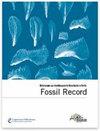下载PDF
{"title":"Taxonomy of Late Jurassic diplodocid sauropods from Tendaguru (Tanzania)","authors":"Kristian Remes","doi":"10.1002/mmng.200800008","DOIUrl":null,"url":null,"abstract":"<p>The Late Jurassic (Tithonian) Tendaguru Beds of Tanzania yielded one of the richest sauropod faunas known, including the diplodocines <i>Tornieria africana</i> (Fraas, 1908) and <i>Australodocus bohetii</i> Remes, 2007, the only known representatives of their group on the southern continents. Historically, the holotypes and referred material of both taxa plus dozens of additional specimens had been subsumed under the term “<i>Barosaurus africanus</i> ” (Fraas, 1908). Here, the taxonomic status of the referred elements is reviewed by evaluating the phylogenetic information content of their anatomical characters, in order to provide a firm footing for further studies (e.g. of morphometrics, histology, and phylogeny of the Tendaguru sauropods). Some of the material shows diplodocine synapomorphies and may belong to either <i>Tornieria</i> or <i>Australodocus</i>, while other specimens are diagnostic only on higher taxonomic levels (Diplodocidae, Flagellicaudata, or Diplodocoidea indet.). The isolated limb elements in most cases lack phylogenetically diagnostic characters. Generally, the “<i>Barosaurus africanus</i> ” sample shows a substantial grade of morphological variation, and it cannot be ruled out that there are more flagellicaudatans represented in the Tendaguru material than the diplodocines and dicraeosaurids already known. (© 2009 WILEY-VCH Verlag GmbH & Co. KGaA, Weinheim)</p>","PeriodicalId":55147,"journal":{"name":"Fossil Record","volume":"12 1","pages":"23-46"},"PeriodicalIF":2.1000,"publicationDate":"2009-02-20","publicationTypes":"Journal Article","fieldsOfStudy":null,"isOpenAccess":false,"openAccessPdf":"https://sci-hub-pdf.com/10.1002/mmng.200800008","citationCount":"31","resultStr":null,"platform":"Semanticscholar","paperid":null,"PeriodicalName":"Fossil Record","FirstCategoryId":"89","ListUrlMain":"https://onlinelibrary.wiley.com/doi/10.1002/mmng.200800008","RegionNum":4,"RegionCategory":"地球科学","ArticlePicture":[],"TitleCN":null,"AbstractTextCN":null,"PMCID":null,"EPubDate":"","PubModel":"","JCR":"Q3","JCRName":"Earth and Planetary Sciences","Score":null,"Total":0}
引用次数: 31
引用
批量引用
Abstract
The Late Jurassic (Tithonian) Tendaguru Beds of Tanzania yielded one of the richest sauropod faunas known, including the diplodocines Tornieria africana (Fraas, 1908) and Australodocus bohetii Remes, 2007, the only known representatives of their group on the southern continents. Historically, the holotypes and referred material of both taxa plus dozens of additional specimens had been subsumed under the term “Barosaurus africanus ” (Fraas, 1908). Here, the taxonomic status of the referred elements is reviewed by evaluating the phylogenetic information content of their anatomical characters, in order to provide a firm footing for further studies (e.g. of morphometrics, histology, and phylogeny of the Tendaguru sauropods). Some of the material shows diplodocine synapomorphies and may belong to either Tornieria or Australodocus , while other specimens are diagnostic only on higher taxonomic levels (Diplodocidae, Flagellicaudata, or Diplodocoidea indet.). The isolated limb elements in most cases lack phylogenetically diagnostic characters. Generally, the “Barosaurus africanus ” sample shows a substantial grade of morphological variation, and it cannot be ruled out that there are more flagellicaudatans represented in the Tendaguru material than the diplodocines and dicraeosaurids already known. (© 2009 WILEY-VCH Verlag GmbH & Co. KGaA, Weinheim)
坦桑尼亚tenaguru地区晚侏罗世梁龙目蜥脚类的分类
坦桑尼亚晚侏罗世(泰托尼亚)的坦达古鲁床上发现了已知最丰富的蜥脚类动物之一,包括非洲托尔尼亚(fras, 1908年)和博赫蒂伊·雷姆斯(Australodocus bohetii Remes, 2007年),它们是南部大陆上唯一已知的蜥脚类代表。历史上,这两个分类群的原型和参考资料加上几十个额外的标本被归入“非洲Barosaurus”(Fraas, 1908)。本文通过对其解剖特征的系统发育信息含量的评价,对所涉及元素的分类地位进行综述,以期为进一步的研究(如:tenaguru蜥脚类的形态计量学、组织学和系统发育)提供坚实的基础。一些材料显示了梁龙科的近亲,可能属于托尔尼亚或南蜥目,而其他标本仅在更高的分类水平上被诊断(梁龙科,鞭毛,或梁龙科indet.)。在大多数情况下,孤立的肢体成分缺乏系统发育诊断特征。总的来说,“非洲Barosaurus”样本显示出相当程度的形态变异,并且不能排除在Tendaguru材料中代表的鞭毛类动物比已知的双龙类和双龙类动物更多。(©2009 WILEY-VCH Verlag GmbH &KGaA公司,Weinheim)
本文章由计算机程序翻译,如有差异,请以英文原文为准。


